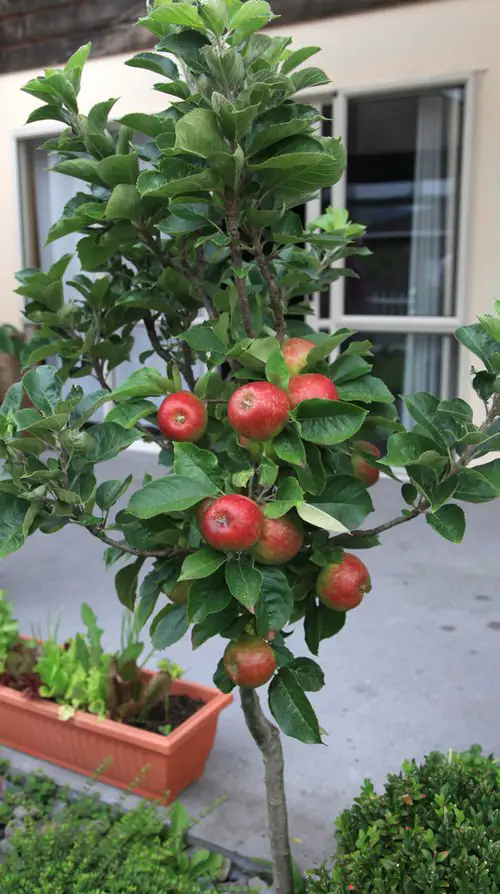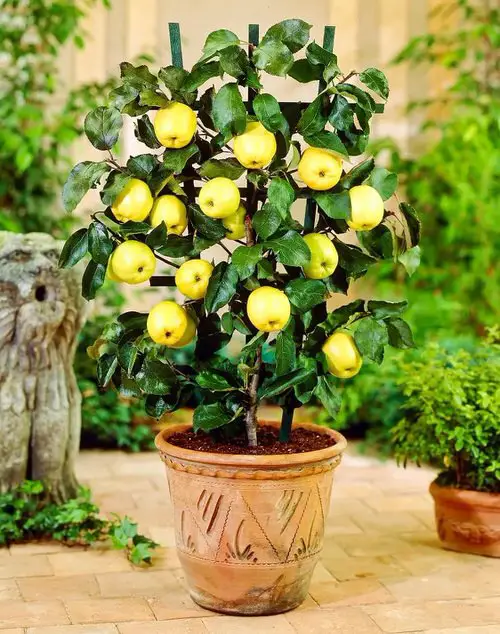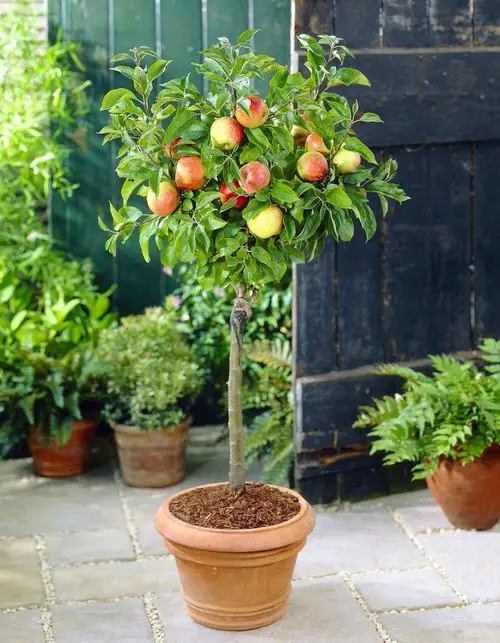Here’s all you need to know about How to Grow An Apple Tree in Container. Growing Apple Trees in Pots is not difficult if you understand the requirements!

Want to know How to Grow An Apple Tree in a Container? We have all the tips and tricks to help you grow it easily in a limited space!
How to Choose the Right Apple Tree?
Growing apple tree from seeds is a bad idea. Instead, buy a dwarf or semi-dwarf grafted tree from a reputed nursery.
Apple trees are grown by grafting on a rootstock, which has many benefits. If you are unaware of apple rootstock grafting, you might like to read more on this on the official website of the Ministry Of Agriculture, Food And Rural Affairs (Ontario) and this very informative article from Cornell University.
Basically, dwarf apple trees are those in which dwarf rootstocks are grafted to control their height and size and to improve fruit production and resistance to diseases and pests.
Go to a nursery or shop online and probe for rootstock choices like M27, M26, Bud9, G16, or M9. Apple trees grown on these rootstocks are dwarf and usually don’t grow above 8 feet. You can also look for semi-dwarf trees. Doing this makes it possible to grow them in containers.
Buy a Self-Fertile Variety of Apple Tree
Apple trees require cross-pollination! You’ll need to buy two apple trees for pollination. If you’re going to plant only one plant, buy a self-pollinating variety.
Considering the Chilling Period
To set flowers, apple trees require an annual cold-weather cycle in winter called chilling. A chilling period requirement of an apple tree is measured from the total number of hours it gets per year when the temperature remains below 45 F (7 C) but above the freezing point.
Average chilling hour requirements for apple tree varieties are around 800-1000 hours, and it can be less or more depending on the type you select.
If you live in a mild winter climate, choose low-chill apple cultivars, and if you live in a harsh winter climate, choose high-chill apple varieties. This simple trick will improve the productivity of your apple tree.
Choosing a Pot for the Apple Tree

Don’t start planting apple trees in a too-large pot initially. The volume of soil and smaller root system will result in overwatering and excessive moisture in the growing medium, which is a big no for the young plant.
A small standard-size pot (5-6 gallons) 10-12 inches deep and wide is great to start with. Gradually change the size of the container every year or two at the start of the growing season or when you identify that the plant is rootbound. You’ll find out if the plant is rootbound or not when it stops growing or you see these rootbound symptoms.
Upgrade your pot in sequence by choosing one size bigger pot than the previous one each time. Once your apple tree in a pot reaches the desired height, stop changing the pots. A 20-25 gallon pot would be sufficient as a final one. After that, you’ll have to do regular pruning and root trimming from time to time to maintain it.
Requirements for Growing Apple Trees in Pots

Position
Like other fruit trees, the apple tree loves to grow in the sun. If you like, on hot summer days (in warmer regions, USDA Zone 8-10), move the container to a place that is shaded from the afternoon sun. Choose a sunny location that’s less windy.
Also, keep in mind to maintain good air circulation around your apple tree. If you are growing it on your balcony or rooftop garden, don’t place it close to the walls.
Temperature
It requires a cool winter and moderate summer. You can’t grow apple trees where the temperature remains the same or way too hot.
But you can easily grow apple trees where the temperature gets cold; they tolerate freezing climates by going dormant in winter.
Watering
Growing apple trees in pots requires regular watering, especially in the first year. Water deeply to promote the formation of healthy roots. And reduce watering in winter.
Apple trees growing in containers commonly die due to root rot in waterlogged soil and excess and frequent watering, so avoid this. In any case, prevent the chances of overwatering the plant again and again.
Also, avoid overhead watering, as wetting the foliage favors the growth of powdery mildew.
Soil
Apple plants prefer deep, fertile, and well-draining substrate, so don’t use soil that thwarts drainage. When grown on the ground, sandy loam to sandy clay loam soil is preferred.
To grow an apple tree in a container, use a potting mix rich in organic matter with a slightly acidic to neutral pH (6-6.8). You can mix compost or well-rotted manure to enrich your growing medium.
Apple Tree Care

Fertilizer
Fertilize your apple tree with a balanced liquid fertilizer, diluted to 1/4 of its strength, when the tree is young every 2-3 weeks during the growing season.
Apply any fruit fertilizer once the tree gets older. Start to reduce the feeding from late fall and stop fertilizing in winter, and don’t start before the warm weather arrives in spring.
Repotting
Repot the young apple tree in a year or two. Transplant in one size bigger pot after scratching and spreading roots from sides and bottom gently.
Overwintering
You must know that during hard frosts and too-cold temperatures, you’ll need to protect the plant’s roots. For this, wrap the container with bubble wrap or move it to an insulated location.
Pests and Diseases
An Apple tree in a container is susceptible to aphids, moths, apple blossom weevils, scabs, powdery mildew, brown rot, etc. Some of them are listed below:
Aphids: These tiny, sap-sucking insects can distort new growth and cause leaves to curl. Regularly inspect your apple tree for aphid infestations and use insecticidal soap or a strong blast of water to control them.
Codling Moth: The larvae of codling moths tunnel into apples, causing internal damage. To prevent infestations, use pheromone traps to monitor adult moth activity and apply appropriate insecticides during their vulnerable stages.
Apple Maggot: These small, whitish larvae create holes through apple fruit, leaving trails and causing fruit drop. Use sticky traps and insecticides targeted at apple maggots to control their population.
Powdery Mildew: This fungal disease appears as a white powdery coating on leaves, stems, and fruit. Adequate air circulation and regular applications of fungicides, such as sulfur-based products, can help manage powdery mildew. You can also try home-based fungicides–some of the DIY recipes are here!
Apple Scab: A common fungal disease that manifests as scaly, dark lesions on leaves, fruit, and stems. Opt for disease-resistant apple varieties and apply fungicides, such as those containing copper, during the growing season to prevent apple scabs.
Fire Blight: This bacterial disease causes blackened, dead branches and cankers on apple trees. Prune affected branches promptly and disinfect tools between cuts to prevent spreading. Copper-based sprays can also be used during the dormant season as a preventive measure.
The good news is–apple tree care in a pot is fairly easy and manageable. You can easily keep an eye on these pests and diseases and take appropriate measures on time.
Pruning Apple Tree
Pruning is an essential part of apple tree care. But a dwarf apple tree requires less pruning than a semi-dwarf or standard-size tree. Pruning must be done to control the shape and size of your plant.
Dead, damaged, or diseased branches must be pruned from time to time. Also, prune off the branches that are crossing each other or growing inside towards the main trunk. The best time for pruning is late winter and spring, and the well-trained specimens can be lightly pruned in summer.
Pollinating Apple Tree
Most apple tree varieties require cross-pollination to fruit, which means you have to buy at least two apple trees. But the best way to avoid this is to search for a self-fertile variety.
Picking Flowers and Fruit Thinning
Dwarf apple trees start to produce flowers in 2-3 years. In the first flowering year, remove all blooms to prevent the tree from setting fruits. This way, you’ll allow the plant to direct its energy into growing.
Fruit thinning allows the plant to grow better-quality fruits. Wait for a few weeks after fruit setting and remove the fruits that are growing too closely.
Harvesting Apple Tree
The apple tree will be ready to grow fruits fully in 3 to 7 years. When ready to harvest, pick one apple from the tree and taste it to know whether the rest are ready to harvest or not. Do not pull the fruit vigorously from the tree, as it might damage the stem. Instead, twist it in a rotating motion technique.
You can store them in a refrigerator for up to 6-8 weeks.



Hi!
I wonder where can i buy dwarf apple tree..i really like this idea..
Thanks,
Yana
I found some at raintreenursery.com. :)
You state that one should not start with a large pot but you do not explain why. If the end result is a 20-25 gallon pot why is it an issue to begin with this size? Will starting with a large pot effect the tree or are you suggesting to start small and move to large to lessen the burden of lugging around 20-25 gallons of dirt when the tree is still an infant?
I’ve been growing plants a while and though I didn’t write the article I may be able to answer this for you. You don’t want to start with a pot too large because you risk over watering. If you put a 3 ft tall tree in a 25 gallon pot, water will pool in areas where roots can’t directly absorb water. You’ll very likely end up suffocating the tree or promoting root rot.
The reason for not using a large pot is because water travels the least resistance. Therefore watering your plant in a too large of a pot will not allow the roots to come in contact with the water, thus negating the process of watering your tree and allowing it to uptake nutrients.
Please can you recommend what time of year to re-pot my Apple tree? Winter months?
Nice process. Where can one buy dwarf apple tree in Kenya
Hello,
We have a large 7ft apple tree in a pot on our balcony that has grown from our compost and we decided to keep him. When is the best time to repot? And we have never pruned; should we?
Why do they use such obviously photoshopped pictures? In the third picture down, it’s the same apple with the same spot near the core that has been duplicated all over the tree. Why not show a real tree, with real results.
OH NO!!! I have already failed by growing an apple tree from seeds from, yes, an apple. So now I have two apple trees in the kitchen window, almost 5 feet tall and about 3 years old. They are pretty weak and thin though — to move them to a floor pot I will probably need to stake them upright with something. About to move them to a 16″ square pot.
All advice welcomed!
Hello I want to buy variety of all fruits tree for my garden.. So pls suggest me to which type of fruit tree is perfect for my garden… From where to buy 100% garanted fruit trees
I started my apple tree with an apple pit. For one year it was on my patio, closed in balcony. Grew slowly, over winter it was too cold, it stopped growing. This year I took the pot inside and the little tree grows continuously, in a few months over one foot. Transplanted it in a slightly larger pot and stands by large window, getting light all day. Thanks for the good advice, not misting from above. Very useful article.
1. I have 5 acres in Zone 4-3 ((Across the St Croix River from Wisconsin)
2. I “air Layered” a 40 year old apple tree late this August, and because it was late in the season I potted it…and its leafing and healthy, however
3. WI winter is coming
4. So what now?…
5. Leave in pot and bring into the farm’s basement, watering appropriately, or
6. Leave outside but dig a hole to bury the tree and pot in the hole, covering
7. Since I grow grapes, I propagate the vineyard with cuttings, each winter after harvest…and grow them in the basement into plants for the coming spring
8.If I put the Apple tree pot in the basement, it would be growing along side of the grapes..
I would appreciate your thoughts, and realize whether or not I follow your advice is up to me, even if it doesn’t work THNX, George
my four years old apple tree in the pot was doing well till three weeks ago. I saw white stuff (mildew ??) all around the root. removed the tree with is about 3-4 feet tall and clean the root. place it in the new pot with new sandy soil, add root hormone and vitamin B-1. this apple tree has already several fruits on it. please advise if this apple tree will make it ?